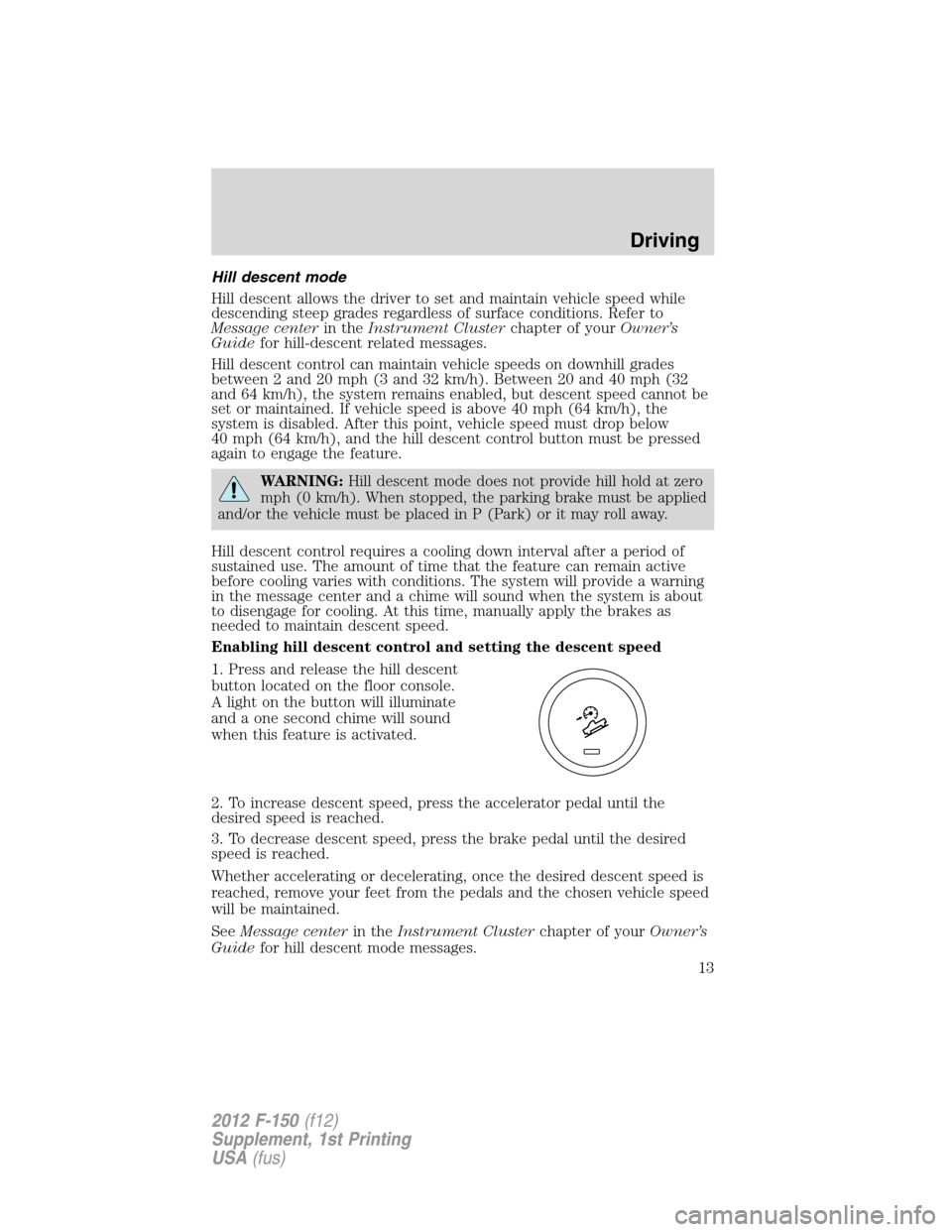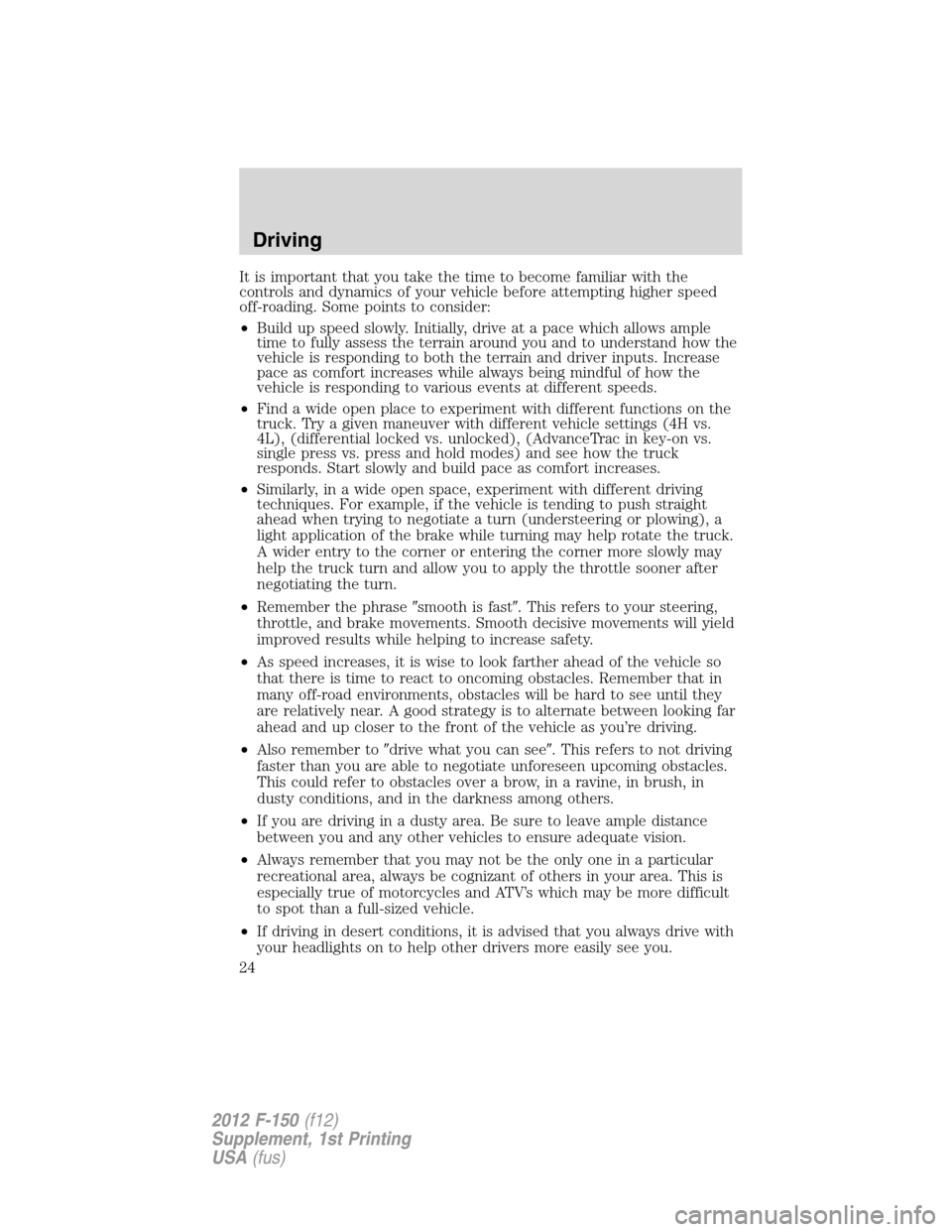Page 13 of 36

Hill descent mode
Hill descent allows the driver to set and maintain vehicle speed while
descending steep grades regardless of surface conditions. Refer to
Message centerin theInstrument Clusterchapter of yourOwner’s
Guidefor hill-descent related messages.
Hill descent control can maintain vehicle speeds on downhill grades
between 2 and 20 mph (3 and 32 km/h). Between 20 and 40 mph (32
and 64 km/h), the system remains enabled, but descent speed cannot be
set or maintained. If vehicle speed is above 40 mph (64 km/h), the
system is disabled. After this point, vehicle speed must drop below
40 mph (64 km/h), and the hill descent control button must be pressed
again to engage the feature.
WARNING:Hill descent mode does not provide hill hold at zero
mph (0 km/h). When stopped, the parking brake must be applied
and/or the vehicle must be placed in P (Park) or it may roll away.
Hill descent control requires a cooling down interval after a period of
sustained use. The amount of time that the feature can remain active
before cooling varies with conditions. The system will provide a warning
in the message center and a chime will sound when the system is about
to disengage for cooling. At this time, manually apply the brakes as
needed to maintain descent speed.
Enabling hill descent control and setting the descent speed
1. Press and release the hill descent
button located on the floor console.
A light on the button will illuminate
and a one second chime will sound
when this feature is activated.
2. To increase descent speed, press the accelerator pedal until the
desired speed is reached.
3. To decrease descent speed, press the brake pedal until the desired
speed is reached.
Whether accelerating or decelerating, once the desired descent speed is
reached, remove your feet from the pedals and the chosen vehicle speed
will be maintained.
SeeMessage centerin theInstrument Clusterchapter of yourOwner’s
Guidefor hill descent mode messages.
Driving
13
2012 F-150(f12)
Supplement, 1st Printing
USA(fus)
Page 20 of 36

•When negotiating low speed obstacles, applying light brake pressure in
conjunction with the throttle will help prevent the vehicle from jerking
and will allow you to negotiate the obstacle in a more controlled
manner. Using 4L will also help with this.
•Use and equip supplemental safety equipment as discussed later in
this chapter.
•Please consult your local off-road group for other helpful tips.
•Off-roading requires a high degree of concentration. Even if your local
law does not prohibit alcohol use while driving off-road, Ford strongly
recommends against drinking if you plan to off-road.
Driving in mud
•Deep mud should be approached with caution especially if you are
driving in an unfamiliar area.
•If possible, test the depth of a mud hole before entering with the
vehicle.
•Keep in mind that obstacles and deep ruts may be hidden beneath the
surface of the mud.
•Proceed in a steady, controlled manner through deep mud while
maintaining momentum.
•If momentum is lost and you feel the vehicle becoming stuck, turning
the steering wheel back and forth (“sawing the wheel”)
1�4turn in
each direction may give the traction you need to clear the muddy
area.
•In higher speed areas with shallow mud, directional control will be
reduced in the muddy area much like on snow or ice. When
approaching such an area, be sure to slow to a speed which allows you
to maneuver as required by the conditions.
Driving in sand
WARNING:Tires must be returned to normal recommended tire
pressures before driving on pavement or hard surfaces. Failure
to properly maintain your tire pressure could increase the risk of tire
failure, loss of control, vehicle rollover and personal injury.
Driving
20
2012 F-150(f12)
Supplement, 1st Printing
USA(fus)
Page 24 of 36

It is important that you take the time to become familiar with the
controls and dynamics of your vehicle before attempting higher speed
off-roading. Some points to consider:
•Build up speed slowly. Initially, drive at a pace which allows ample
time to fully assess the terrain around you and to understand how the
vehicle is responding to both the terrain and driver inputs. Increase
pace as comfort increases while always being mindful of how the
vehicle is responding to various events at different speeds.
•Find a wide open place to experiment with different functions on the
truck. Try a given maneuver with different vehicle settings (4H vs.
4L), (differential locked vs. unlocked), (AdvanceTrac in key-on vs.
single press vs. press and hold modes) and see how the truck
responds. Start slowly and build pace as comfort increases.
•Similarly, in a wide open space, experiment with different driving
techniques. For example, if the vehicle is tending to push straight
ahead when trying to negotiate a turn (understeering or plowing), a
light application of the brake while turning may help rotate the truck.
A wider entry to the corner or entering the corner more slowly may
help the truck turn and allow you to apply the throttle sooner after
negotiating the turn.
•Remember the phrase�smooth is fast�. This refers to your steering,
throttle, and brake movements. Smooth decisive movements will yield
improved results while helping to increase safety.
•As speed increases, it is wise to look farther ahead of the vehicle so
that there is time to react to oncoming obstacles. Remember that in
many off-road environments, obstacles will be hard to see until they
are relatively near. A good strategy is to alternate between looking far
ahead and up closer to the front of the vehicle as you’re driving.
•Also remember to�drive what you can see�. This refers to not driving
faster than you are able to negotiate unforeseen upcoming obstacles.
This could refer to obstacles over a brow, in a ravine, in brush, in
dusty conditions, and in the darkness among others.
•If you are driving in a dusty area. Be sure to leave ample distance
between you and any other vehicles to ensure adequate vision.
•Always remember that you may not be the only one in a particular
recreational area, always be cognizant of others in your area. This is
especially true of motorcycles and ATV’s which may be more difficult
to spot than a full-sized vehicle.
•If driving in desert conditions, it is advised that you always drive with
your headlights on to help other drivers more easily see you.
Driving
24
2012 F-150(f12)
Supplement, 1st Printing
USA(fus)